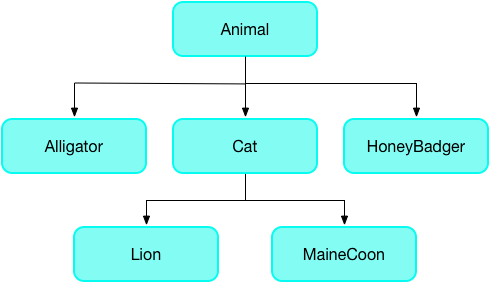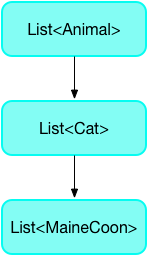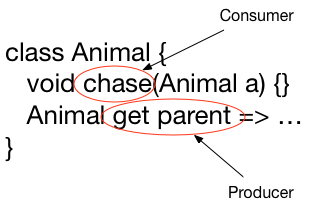目录
Contents
Dart 是类型安全的编程语言:Dart 使用静态类型检查和 运行时检查 的组合来确保变量的值始终与变量的静态类型或其他安全类型相匹配。尽管类型是必需的,但由于 类型推断,类型的注释是可选的。
The Dart language is type safe: it uses a combination of static type checking and runtime checks to ensure that a variable’s value always matches the variable’s static type, sometimes referred to as sound typing. Although types are mandatory, type annotations are optional because of type inference.
本章重点介绍 Dart 2 中添加的类型安全功能。有关 Dart 语言的完整介绍(包括类型),请参阅语言概览。
This page concentrates on the type safety features added in Dart 2. For a full introduction to the Dart language, including types, see the language tour.
有关 Dart 语言的完整介绍(包括类型),请参阅语言指南。
For a full introduction to the Dart language, including types, see the language tour.
静态类型检查的一个好处是能够使用 Dart 的 静态分析器 在编译时找到错误。
One benefit of static type checking is the ability to find bugs at compile time using Dart’s static analyzer.
可以向泛型类添加类型注释来修复大多数静态分析错误。最常见的泛型类是集合类型 List<T> 和 Map<K,V> 。
You can fix most static analysis errors by adding type annotations to generic
classes. The most common generic classes are the collection types
List<T> and Map<K,V>.
例如,在下面的代码中,main() 创建一个列表并将其传递给 printInts(),由 printInts() 函数打印这个整数列表。
For example, in the following code the printInts() function prints an integer list,
and main() creates a list and passes it to printInts().
void printInts(List<int> a) => print(a);
void main() {
var list = [];
list.add(1);
list.add("2");
printInts(list);
}上面的代码在调用 printInts(list) 时会在 list (高亮提示)上产生类型错误:
The preceding code results in a type error on list (highlighted
above) at the call of printInts(list):
error • The argument type 'List<dynamic>' can't be assigned to the parameter type 'List<int>' • argument_type_not_assignable
高亮错误是因为产生了从 List<dynamic> 到 List<int> 的不正确的隐式转换。
list 变量是 List<dynamic> 静态类型。这是因为 list 变量的初始化声明 var list = []
没有为分析器提供足够的信息来推断比 dynamic 更具体的类型参数。
printInts() 函数需要 List<int> 类型的参数,因此导致类型不匹配。
The error highlights an unsound implicit cast from List<dynamic> to List<int>.
The list variable has static type List<dynamic>. This is because the
initializing declaration var list = [] doesn’t provide the analyzer with
enough information for it to infer a type argument more specific than dynamic.
The printInts() function expects a parameter of type List<int>,
causing a mismatch of types.
在创建 list 时添加类型注释 <int>(代码中高亮显示部分)后,分析器会提示无法将字符串参数分配给 int 参数。删除 list.add("2") 中的字符串引号使代码通过静态分析并能够正常执行。
When adding a type annotation (<int>) on creation of the list
(highlighted below) the analyzer complains that a string argument can’t be assigned to
an int parameter. Removing the quotes in list.add("2") results
in code that passes static analysis and runs with no errors or warnings.
void printInts(List<int> a) => print(a);
void main() {
var list = <int>[];
list.add(1);
list.add(2);
printInts(list);
}什么是类型安全
What is soundness?
类型安全是为了确保程序不会进入某些无效状态。安全的类型系统意味着程序永远不会进入表达式求值为与表达式的静态类型不匹配的值的状态。例如,如果表达式的静态类型是 String ,则在运行时保证在评估它的时候只会获取字符串。
Soundness is about ensuring your program can’t get into certain
invalid states. A sound type system means you can never get into
a state where an expression evaluates to a value that doesn’t match
the expression’s static type. For example, if an expression’s static
type is String, at runtime you are guaranteed to only get a string
when you evaluate it.
Dart 的类型系统,同 Java 和 C#中的类型系统类似,是安全的。它使用静态检查(编译时错误)和运行时检查的组合来强制执行类型安全。例如,将 String 分配给 int 是一个编译时错误。如果对象不是字符串,使用 as String 将对象转换为字符串时,会由于运行时错误而导致转换失败。
Dart’s type system, like the type systems in Java and C#, is sound. It
enforces that soundness using a combination of static checking
(compile-time errors) and runtime checks. For example, assigning a String
to int is a compile-time error. Casting an Object to a string using
as String fails with a runtime error if the object isn’t a
string.
类型安全的好处
The benefits of soundness
安全的类型系统有以下几个好处:
A sound type system has several benefits:
-
在编译时就可以检查并显示类型相关的错误。
安全的类型系统强制要求代码明确类型,因此在编译时会显示与类型相关的错误,这些错误可能在运行时可能很难发现。Revealing type-related bugs at compile time.
A sound type system forces code to be unambiguous about its types, so type-related bugs that might be tricky to find at runtime are revealed at compile time. -
代码更容易阅读。
代码更容易阅读,因为我们信赖一个拥有指定类型的值。在类型安全的 Dart 中,类型是不会骗人的。因为一个拥有指定类型的值是可以被信赖的。More readable code.
Code is easier to read because you can rely on a value actually having the specified type. In sound Dart, types can’t lie. -
代码可维护性更高。
在安全的类型系统下,当更改一处代码后,类型系统会警告因此影响到的其他代码块。More maintainable code.
With a sound type system, when you change one piece of code, the type system can warn you about the other pieces of code that just broke. -
更好的 AOT 编译。
虽然在没有类型的情况下可以进行 AOT 编译,但生成的代码效率要低很多。Better ahead of time (AOT) compilation.
While AOT compilation is possible without types, the generated code is much less efficient.
静态检查中的一些技巧
Tips for passing static analysis
大多数静态类型的规则都很容易理解。下面是一些不太明显的规则:
Most of the rules for static types are easy to understand. Here are some of the less obvious rules:
-
重写方法时,使用类型安全返回值。
Use sound return types when overriding methods.
-
重写方法时,使用类型安全的参数。
Use sound parameter types when overriding methods.
-
不要将动态类型的 List 看做是有类型的 List。
Don’t use a dynamic list as a typed list.
让我们通过下面示例的类型结构,来更深入的了解这些规则:
Let’s see these rules in detail, with examples that use the following type hierarchy:

重写方法时,使用类型安全的返回值
Use sound return types when overriding methods
子类方法中返回值类型必须与父类方法中返回值类型的类型相同或其子类型。考虑 Animal 类中的 Getter 方法:
The return type of a method in a subclass must be the same type or a subtype of the return type of the method in the superclass. Consider the getter method in the Animal class:
class Animal {
void chase(Animal a) { ... }
Animal get parent => ...
}父类 Getter 方法返回一个 Animal 。在 HoneyBadger 子类中,可以使用 HoneyBadger(或 Animal 的任何其他子类型)替换 Getter 的返回值类型,但不允许使用其他的无关类型。
The parent getter method returns an Animal. In the HoneyBadger subclass,
you can replace the getter’s return type with HoneyBadger (or any other subtype
of Animal), but an unrelated type is not allowed.
class HoneyBadger extends Animal {
void chase(Animal a) { ... }
HoneyBadger get parent => ...
}class HoneyBadger extends Animal {
void chase(Animal a) { ... }
Root get parent => ...
}重写方法时,使用类型安全的参数。
Use sound parameter types when overriding methods
子类方法的参数必须与父类方法中参数的类型相同或是其参数的父类型。不要使用原始参数的子类型,替换原有类型,这样会导致参数类型”收紧”。
The parameter of an overridden method must have either the same type or a supertype of the corresponding parameter in the superclass. Don’t “tighten” the parameter type by replacing the type with a subtype of the original parameter.
考虑 Animal 的 chase(Animal) 方法:
Consider the chase(Animal) method for the Animal class:
class Animal {
void chase(Animal a) { ... }
Animal get parent => ...
}chase() 方法的参数类型是 Animal 。一个 HoneyBadger 可以追逐任何东西。因此可以在重写 chase() 方法时将参数类型指定为任意类型(Object)。
The chase() method takes an Animal. A HoneyBadger chases anything.
It’s OK to override the chase() method to take anything (Object).
class HoneyBadger extends Animal {
void chase(Object a) { ... }
Animal get parent => ...
}Mouse 是 Animal 的子类,下面的代码将 chase() 方法中参数的范围从 Animal 缩小到 Mouse 。
The following code tightens the parameter on the chase() method
from Animal to Mouse, a subclass of Animal.
class Mouse extends Animal {...}
class Cat extends Animal {
void chase(Mouse x) { ... }
}下面的代码不是类型安全的,因为 a 可以是一个 cat 对象,却可以给它传入一个 alligator 对象。
This code is not type safe because it would then be possible to define a cat and send it after an alligator:
Animal a = Cat();
a.chase(Alligator()); // Not type safe or feline safe不要将动态类型的 List 看做是有类型的 List
Don’t use a dynamic list as a typed list
当期望在一个 List 中可以包含不同类型的对象时,动态列表是很好的选择。但是不能将动态类型的 List 看做是有类型的 List 。
A dynamic list is good when you want to have a list with different kinds of things in it. However, you can’t use a dynamic list as a typed list.
这个规则也适用于泛型类型的实例。
This rule also applies to instances of generic types.
下面代码创建一个 Dog 的动态 List ,并将其分配给 Cat 类型的 List ,表达式在静态分析期间会产生错误。
The following code creates a dynamic list of Dog, and assigns it to a list of type Cat, which generates an error during static analysis.
class Cat extends Animal { ... }
class Dog extends Animal { ... }
void main() {
List<Cat> foo = <dynamic>[Dog()]; // Error
List<dynamic> bar = <dynamic>[Dog(), Cat()]; // OK
}运行时检查
Runtime checks
运行时检查工具,比如 Dart VM 和 dartdevc,处理分析器无法捕获的类型安全问题。
Runtime checks in tools like the Dart VM and dartdevc deal with type safety issues that the analyzer can’t catch.
例如,以下代码在运行时会抛出异常,因为将 Dog 类型的 List 赋值给 Cat 类型的 List 是错误的:
For example, the following code throws an exception at runtime because it is an error to assign a list of Dogs to a list of Cats:
void main() {
List<Animal> animals = [Dog()];
List<Cat> cats = animals;
}类型推断
Type inference
分析器(analyzer)可以推断字段,方法,局部变量和大多数泛型类型参数的类型。当分析器没有足够的信息来推断出一个特定类型时,会使用 dynamic 作为类型。
The analyzer can infer types for fields, methods, local variables,
and most generic type arguments.
When the analyzer doesn’t have enough information to infer
a specific type, it uses the dynamic type.
下面是在泛型中如何进行类型推断的示例。在此示例中,名为 arguments 的变量包含一个 Map ,该 Map 将字符串键与各种类型的值配对。
Here’s an example of how type inference works with generics.
In this example, a variable named arguments holds a map that
pairs string keys with values of various types.
如果显式键入变量,则可以这样写:
If you explicitly type the variable, you might write this:
Map<String, dynamic> arguments = {'argA': 'hello', 'argB': 42};或者,使用 var 让 Dart 来推断类型:
Alternatively, you can use var and let Dart infer the type:
var arguments = {'argA': 'hello', 'argB': 42}; // Map<String, Object>Map 字面量从其条目中推断出它的类型,然后变量从 Map 字面量的类型中推断出它的类型。在此 Map 中,键都是字符串,但值具有不同的类型( String 和 int ,它们具有共同的上限类型 Object )。因此,Map 字面量的类型为 Map<String, Object> ,也就是 arguments 的类型。
The map literal infers its type from its entries,
and then the variable infers its type from the map literal’s type.
In this map, the keys are both strings, but the values have different
types (String and int, which have the upper bound Object).
So the map literal has the type Map<String, Object>,
and so does the arguments variable.
字段和方法推断
Field and method inference
重写父类的且没有指定类型的字段或方法,继承父类中字段或方法的类型。
A field or method that has no specified type and that overrides a field or method from the superclass, inherits the type of the superclass method or field.
没有声明类型且不存在继承类型的字段,如果在声明时被初始化,那么字段的类型为初始化值的类型。
A field that does not have a declared or inherited type but that is declared with an initial value, gets an inferred type based on the initial value.
静态字段推断
Static field inference
静态字段和变量的类型从其初始化程序中推断获得。需要注意的是,如果推断是个循环,推断会失败(也就是说,推断变量的类型取决于知道该变量的类型)。
Static fields and variables get their types inferred from their initializer. Note that inference fails if it encounters a cycle (that is, inferring a type for the variable depends on knowing the type of that variable).
局部变量推断
Local variable inference
在不考虑连续赋值的情况下,局部变量如果有初始化值的情况下,其类型是从初始化值推断出来的。这可能意味着推断出来的类型会非常严格。如果是这样,可以为他们添加类型注释。
Local variable types are inferred from their initializer, if any. Subsequent assignments are not taken into account. This may mean that too precise a type may be inferred. If so, you can add a type annotation.
var x = 3; // x is inferred as an int
x = 4.0;num y = 3; // a num can be double or int
y = 4.0;参数类型推断
Type argument inference
构造函数调用的类型参数和 泛型方法调用是根据上下文的向下信息和构造函数或泛型方法的参数的向上信息组合推断的。如果推断没有按照意愿或期望进行,那么你可以显式的指定他们的参数类型。
Type arguments to constructor calls and generic method invocations are inferred based on a combination of downward information from the context of occurrence, and upward information from the arguments to the constructor or generic method. If inference is not doing what you want or expect, you can always explicitly specify the type arguments.
// Inferred as if you wrote <int>[].
List<int> listOfInt = [];
// Inferred as if you wrote <double>[3.0].
var listOfDouble = [3.0];
// Inferred as Iterable<int>
var ints = listOfDouble.map((x) => x.toInt());在最后一个示例中,根据向下信息 x 被推断为 double 。闭包的返回类型根据向上信息推断为 int 。在推断 map() 方法的类型参数:<int> 时,Dart 使用此返回值的类型作为向上信息。
In the last example, x is inferred as double using downward information.
The return type of the closure is inferred as int using upward information.
Dart uses this return type as upward information when inferring the map()
method’s type argument: <int>.
替换类型
Substituting types
当重写方法时,可以使用一个新类型(在新方法中)替换旧类型(在旧方法中)。类似地,当参数传递给函数时,可以使用另一种类型(实际参数)的对象替换现有类型(具有声明类型的参数)要求的对象。什么时候可以用具有子类型或父类型的对象替换具有一种类型的对象那?
When you override a method, you are replacing something of one type (in the old method) with something that might have a new type (in the new method). Similarly, when you pass an argument to a function, you are replacing something that has one type (a parameter with a declared type) with something that has another type (the actual argument). When can you replace something that has one type with something that has a subtype or a supertype?
从_消费者_和_生产者_的角度有助于我们思考替换类型的情况。消费者接受类型,生产者产生类型。
When substituting types, it helps to think in terms of consumers and producers. A consumer absorbs a type and a producer generates a type.
可以使用父类型替换消费者类型,使用子类型替换生产者类型。
You can replace a consumer’s type with a supertype and a producer’s type with a subtype.
下面让我们看一下普通类型赋值和泛型类型赋值的示例。
Let’s look at examples of simple type assignment and assignment with generic types.
普通类型赋值
Simple type assignment
将对象赋值给对象时,什么时候可以用其他类型替换当前类型?答案取决于对象是消费者还是生产者。
When assigning objects to objects, when can you replace a type with a different type? The answer depends on whether the object is a consumer or a producer.
分析以下类型层次结构:
Consider the following type hierarchy:

思考下面示例中的普通赋值,其中 Cat c 是_消费者_而 Cat() 是_生产者_:
Consider the following simple assignment where Cat c is a consumer and Cat()
is a producer:
Cat c = Cat();在消费者的位置,任意类型(Animal)的对象替换特定类型(Cat)的对象是安全的。因此使用 Animal c 替换 Cat c 是允许的,因为 Animal 是 Cat 的父类。
In a consuming position, it’s safe to replace something that consumes a
specific type (Cat) with something that consumes anything (Animal),
so replacing Cat c with Animal c is allowed, because Animal is
a supertype of Cat.
Animal c = Cat();但是使用 MaineCoon c 替换 Cat c 会打破类型的安全性,因为父类可能会提供一种具有不同行为的 Cat ,例如 Lion :
But replacing Cat c with MaineCoon c breaks type safety, because the
superclass may provide a type of Cat with different behaviors, such
as Lion:
MaineCoon c = Cat();在生产者的位置,可以安全地将生产类型 (Cat) 替换成一个更具体的类型(MaineCoon)的对象。因此,下面的操作是允许的:
In a producing position, it’s safe to replace something that produces a type (Cat) with a more specific type (MaineCoon). So, the following is allowed:
Cat c = MaineCoon();泛型赋值
Generic type assignment
上面的规则同样适用于泛型类型吗?是的。考虑动物列表的层次结构— Cat 类型的 List 是 Animal 类型 List 的子类型,是 MaineCoon 类型 List 的父类型。
Are the rules the same for generic types? Yes. Consider the hierarchy of lists of animals—a List of Cat is a subtype of a List of Animal, and a supertype of a List of MaineCoon:

在下面的示例中,可以将 MaineCoon 类型的 List 赋值给 myCats ,因为 List<MaineCoon> 是 List<Cat> 的子类型:
In the following example, you can assign a MaineCoon list to myCats because
List<MaineCoon> is a subtype of List<Cat>:
List<Cat> myCats = List<MaineCoon>();从另一个角度看?可以将 Animal 类型的 List 赋值给 List<Cat> 吗?
What about going in the other direction? Can you assign an Animal list to a List<Cat>?
List<Cat> myCats = List<Animal>();上面的赋值通过了静态分析,但它进行了隐式的强制转换。上面的赋值相当于:
This assignment passes static analysis, but it creates an implicit cast. It is equivalent to:
List<Cat> myCats = List<Animal>() as List<Cat>;代码在运行时可能会执行失败。通过在 静态分析配置文件
中指定 implicit-casts: false 来禁止隐式强制转换。
The code may fail at runtime. You can disallow implicit casts
by specifying implicit-casts: false in the analysis options file.
方法
Methods
在重写方法中,生产者和消费者规则仍然适用。例如:
When overriding a method, the producer and consumer rules still apply. For example:

对于使用者(例如 chase(Animal) 方法),可以使用父类型替换参数类型。对于生产者(例如 父类 的 Getter 方法),可以使用子类型替换返回值类型。
For a consumer (such as the chase(Animal) method), you can replace
the parameter type with a supertype. For a producer (such as
the parent getter method), you can replace the return type with
a subtype.
有关更多信息,请参阅 重写方法时,使用类型安全的返回值 以及 重写方法时,使用类型安全的参数。
For more information, see Use sound return types when overriding methods and Use sound parameter types when overriding methods.
其他资源
Other resources
以下是更多关于 Dart 类型安全的相关资源:
The following resources have further information on sound Dart:
-
修复常见类型问题 - 编写类型安全的 Dart 代码时可能遇到的错误,以及解决错误的方法。
Fixing common type problems - Errors you may encounter when writing sound Dart code, and how to fix them.
-
Dart 2 - 如何从 Dart 1.x 代码迁移到 Dart 2 。
Dart 2 - How to update Dart 1.x code to Dart 2.
-
Customizing static analysis - 如何使用分析配置文件设置及自定义分析器和 linter。
Customizing static analysis - How to set up and customize the analyzer and linter using an analysis options file.